importing
advertisement
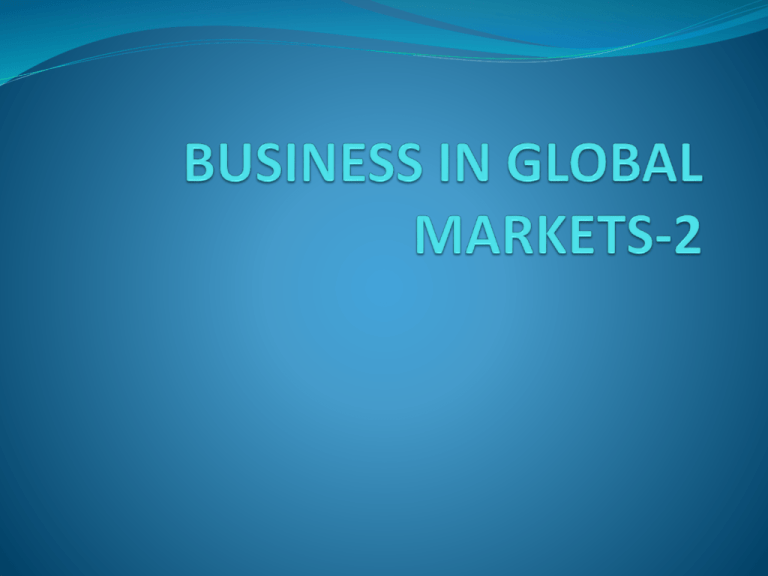
Getting involved in global trade People interested in finding job in international business often think 3- of firms like Boeing, Ford, IBM, and Du Pont that have large multinational accounts. But the real job potential in global markets may be with small businesses. Getting started is often a matter of observation, determination and risk. First of all, it is important to observe and study global markets. the college library, and the internet are good starting points for doing research. Travel is a way to learn about cultures and lifestyles in other countries. It can also be a source of business inspiration. Global Trade Goods & Services Importing Exporting Measuring Trade Balance of Trade/Payments Trade Deficit 3-3 BASIC STAGES IN GLOBAL BUSINESS EXPORTING, IMPORTING, COUNTERTRADING FRANCHISING, FOREIGN LICENCING, SUBCONTRACTING OVERSEAS MARKETING, OVERSEAS PRODUCTION, INT’L JOINT VENTURES, INT’L MERGERS AND ACQUISITIONS IMPORTING : BUYING FOREIGN GOODS AND SERVICES FROM OTHER COUNTRIES TO BE SOLD IN THE LOCAL MARKET EXPORTING : SELLING DOMESTICALLY PRODUCED GOODS AND SERVICES TO OTHER COUNTRIES BALANCE OF TRADE : THE RELATIONSHIP BETWEEN A COUNTRY’S IMPORT AND EXPORT * TRADE DEFICIT : EXPORT < IMPORT (UNFAVORABLE) * TRADE SURPLUS: EXPORT > IMPORT (FAVORABLE) Getting involved in global trade Importing goods and services Can you think of goods and services currently not available in our economy that might appeal to Turkish customers? Howard Schultz the owner of Starbucks, while traveling in Italy he came to appreciate the special sense of community the neighborhood coffee and espresso bars enjoyed in Italian communities. When he returned home to The US, he purchased the Starbucks coffee shop in Seattle and proceeded to build into an international phenomenon. Today Starbucks has stores around the world. 3-6 Getting involved in global trade Exporting goods and services You can sell just about any goods or services to other countries as long as you make good quality products. When you export products or services, you may need to adapt them to the country you sell? 3-7 Getting involved in global trade Measuring global trade 3-8 In measuring the effectiveness of global trade nations should carefully follow two indicators: balance of trade and balance of payments. Balance of trade is a nation’s relationship of exports to imports. A favorable balance of trade, or trade surplus, occurs when the value of a country’s exports exceeds that of its imports. An unfavorable balance of trade, or trade deficit, occurs when the value of the country’s import exceeds that of its exports. That is why countries prefer to export more than they import. Measuring global trade The balance of payments is the difference between money coming into a country (from exports) and money leaving the country (for imports) plus money flows coming into or leaving country from other factors such as tourism, foreign aid, military expenditures, and foreign investment. The goal is always to have more money flowing into country than flowing out. A favorable balance of payments means more money is flowing into a country than flowing out. Conversely, an unfavorable balance of payments is when more money is flowing out of country than coming in. Measuring global trade To make sure that trade is conducted fairly on global basis, different countries enforce laws to prohibit unfair practices such as dumping. Dumping is the practice of selling products in a foreign country at lower prices than those charged in the producing country. Companies use this technique to reduce surplus products in foreign markets or to gain foothold in a new market. BALANCE OF PAYMENTS: OVERALL MONEYFLOW INTO OR OUT OF A COUNTRY * BALANCE OF PAYMENT SURPLUS : INCOMING MONEYFLOW > OUTGOING MONEYFLOW * BALANCE OF PAYMENT DEFICIT : INCOMING MONEYFLOW < OUTGOING MONEYFLOW EXCHANGE RATES VALUE OF NATION’S LOCAL CURRENCY IN RELATION TO THE CURRENCIES OF OTHER COUNTRIES NECESSARY DOCUMENTS IN FOREIGN TRADE INVOICE PACKING LIST INSURANCE POLICY BILL OF LADING CUSTOM PAYMENT RECEIPT DELIVERY TERMS DELIVERY TERMS EXWORKS FREE ON BOARD(FOB) COST AND FREIGHT (CF) COST, INSURANCE AND FREIGHT (CIF) PAYMENT TERMS PAYMENT TERMS CASH WITH ORDER LETTER OF CREDIT(LC) CASH AGAINST DOCUMENTS(CAD) CASH AGAINST GOODS (CAG) BARTERING The pros and cons of free trade Pros The global market contains over 6 billion potential 3- customers for goods and services Productivity grows when countries produce goods and services in which they have a comparative advantage Global competition and lower cost imports keep prices down Open trade encourages innovation, with fresh ideas coming from foreign markets Uninterrupted flow of capital give countries access to foreign investments, which keeps interest rates low. The pros and cons of free trade Cons Domestic workers in manufacturing and service sectors lose jobs due to increased imports or production shifts to global markets Workers can face pay-cut demands from employers Competitive pressure often makes services and goods better quality Domestic companies can lose their comparative advantage when competitors build advanced production operations in low wage countries Strategies for Reaching Global Markets Licensing Exporting Joint Ventures Strategic Alliances Subsidiaries-MNCs Franchising Foreign Direct Contract Manufacturing 3-17 Investment Strategies for Reaching Global Markets Licensing: a firm (the licensor) may decide to compete in global market by licensing the right to manufacture its products or use its trademark to a foreign company for a fee of loyalty A company with an interest in licensing generally needs to send company representatives to the foreign producer to help set up the production process. The licensor may also assist or work with a licensee in such areas as distribution and promotion. 3-18 Strategies for Reaching Global Markets Franchising Contract manufacturing involves a foreign country’s production of 3-19 private-label goods to which a domestic company then attaches its own brand name or trademark. A contract manufacturer ("CM") is a firm that manufactures components or products for another "hiring" firm. Levi-Strauss and Nike practice contract manufacturing. Contract manufacturing often enables a company to experiment in a new market without incurring heavy start up cost. A firm can also use it temporarily to meet an unexpected increase in orders. Contract manufacturing is also called outsourcing Strategies for Reaching Global Markets International joint ventures: a joint venture is a partnership in which two or more companies (often from different countries) join to undertake a major project. Koç-Allianze insurance company. Companies participating joint ventures grow faster than those not participating. 3-20 Strategies for Reaching Global Markets Sometimes joint ventures are mandated by governments. For example, it is often hard to gain entry into a country like China, whose economy is centrally planned, but agreeing to a joint venture can help a firm gain such entry. Most joint ventures are usually limited to specific time frame. However, some extend many years as in the case of Xerox and Fuji photo film company. 3-21 Strategies for Reaching Global Markets Advantages of international joint ventures Shared technology Shared management and marketing expertise Entry into markets where foreign companies are not allowed unless their goods are produced locally Shared risk One obvious disadvantage is that a partner can learn the other’s technology and practices and then go off on its own as a competitor. 3-22 Strategies for Reaching Global Markets Strategic alliance is a long term partnership between two or 3-23 more companies established to help each company build competitive market advantages. Such alliances can provide access to markets, capital, and technological expertise. Unless joint ventures, strategic alliances do not share costs, risks, management or even profits. Many executives and management consultants predict that few companies in the 21 st century will not succeed in the global market by going it alone, most will need strategic alliances. Computer giant Oracle has strategic alliances with more than 15,000 companies, one of which is Ford. Strategies for Reaching Global Markets Foreign subsidiary is a company that is owned in a foreign country by another company (called parent company). Such a subsidiary would operate much like a domestic firm, with production, distribution, promotion, pricing, and other business functions are under the control of the foreign subsidiary's management. 3-24 Strategies for Reaching Global Markets Advantage of a subsidiary The company has complete control over any technology or expertise it may posses. Food giant Nestle is an example for a firm with many foreign subsidiaries. Disadvantage of a subsidiary Parent company is committing a large amount of funds and technology within foreign boundaries. If relationships with the host country falter, the firm’s assets could be taken over by the foreign government. 3-25 Strategies for Reaching Global Markets Foreign direct investment is the buying of permanent property and business in foreign nations. In 1980’s the surge in foreign direct investment by countries such as Japan caused much concern in the US. Japan owns American landmarks such as Rockefeller Center and Columbia pictures. Foreign direct investment can be viewed as a sign of strength in a nation’s economy. The time to worry is when investors no longer find a country attractive. 3-26 Starbucks Around the World World Locations 26% International Locations 1% 23% 74% 6% 15% International Source: Business 2.0, July 2002. 3-27 30% U.S. 25% Japan U.K. Taiwan/China Mid-East Europe All Others Sources of U.S. Oil Imports 471 In Millions of Barrels 307 495 509 Saudi Arabia Mexico Canada Venezuela Nigeria 588 Source: USA Today 3-28 Sources of Foreign Direct Investments In the U.S. Japan 5% Canada 11% Other 4% Europe minus Britain 32% Asia 13% Latin America 17% Source: U.S. Commerce Dept. 3-29 Britain 18%
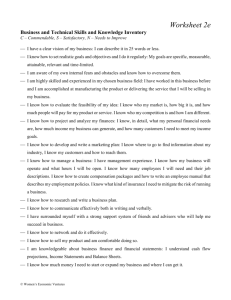
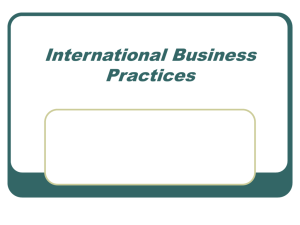
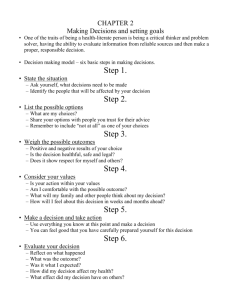

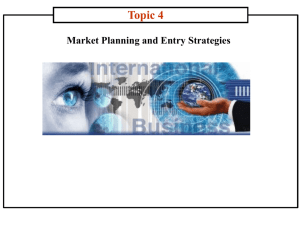


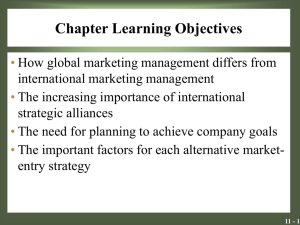

![Quiz About [Your Topic]](http://s3.studylib.net/store/data/009237721_1-467865351cf76015d6a722694bb95331-300x300.png)